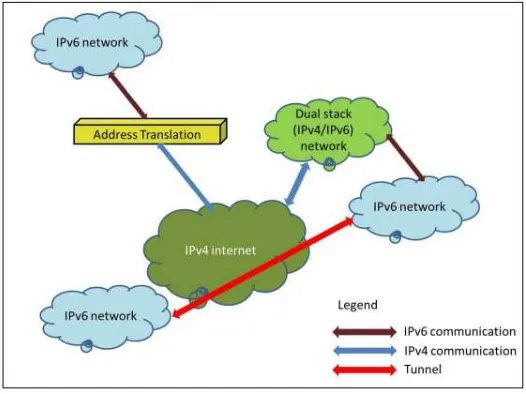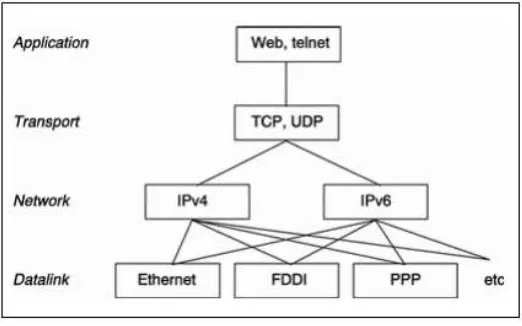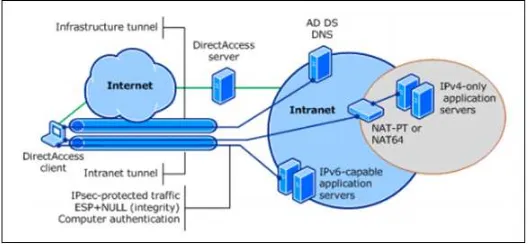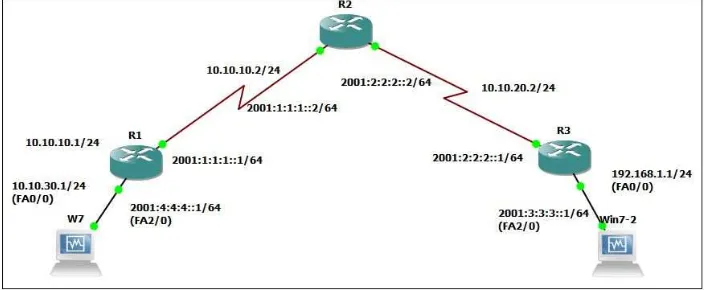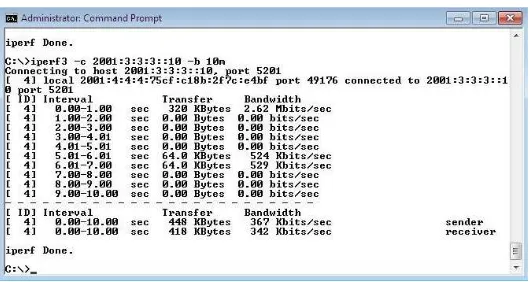Palembang-Indonesia, 19-20 February 2016
Performance Analysis for Migration Method IPv4 to IPv6
Using Dual-Stack Technique
Aan Restu Mukti, Zainuddin Ismail, Edi Surya Negara
Postgraduate Program, Universitas Bina Darma Jalan Ahmad Yani No.3, Plaju, Palembang
e-mail: [email protected], [email protected], [email protected]
Abstract
With the exhaustion of the IPv4 addressing space quickly approaching, it has become a high priority for service providers, enterprises, IP appliances manufacturers, ap-plication developers, and governments to begin their own deployments of IPv6. A seamless migration from IPv4 to IPv6 is hard to achieve. Therefore several mecha-nisms are required which ensures smooth, stepwise and independent change to IPV6. Not only is the transition, integration of IPv6 is also required into the existing net-works. The solutions (or mechanisms) can be divided into three categories: dual stack, tunneling and translation. This paper discuss about IPV4 and IPV6 and use manual transition strategies and automatic of IPV6 and also compare their perfor-mances to show how these transition strategies affects network behavior. In this project the Dual-Stack transition mechanism is implemented in GNS3 (Graphical Network Simulator), using CISCO routers. The operation of this network is viewed with the help of Iperf. The topology uses Dual-Stack technologies, which can be observed by capturing the packets in the Client PC.
Keywords : Internet Protocol, Migration, IPv4, IPv6, Dual-Stack
1 INTRODUCTION
With the majority of networks still utilizing IPv4, there are currently no serious motiva-tional factors to move over to a new method of working when the current provision is still adequate for the majority of users. The debate has been ongoing for years in terms of whether IPv6 should be deployed, hence very few migration plans have been made in the industry [1]. This paper first reviews the current worldwide IPv6 deployment, and compares the tech-nical aspects of the available IPv4-to-IPv6 migration solutions, then discusses the debate on the demand for IPv6 technology. In the following section, the difficulties and challenges of IPv4-to-IPv6 migration with dual-stacks simulation will be addressed together with suggested solutions. Migration strategy will be given as well as proposed decision-making guidelines. The last section will conclude this paper.
2 TRANSITION MECHANISMS
The transition from IPv4 to IPv6 is not a one-day step and involves a lot of changes in network structures with the use of IP addresses. For the future success of IPv6, the next step in deploying IPv6 is to vote for the most suitable transition methods and their management. Although many kinds of transition mechanisms have been invented to help with the process, the implementation of IPv6 is never said to be easy and simple, even for experienced administrators. As a result, the most difficult problem to make decisions for is which method will be chosen for the implementation process to achieve a smooth and seamless transition [2].
Figure 1: Different transition technologies (Subramanian 2003)
matter to opt out the best methods for large enterprise networks. Each technique possesses individual attributes and plays an important part in the transition process. In general, these techniques can be divided into three categories (figure 1) [3].
2.1 Dual-Stack
However, despite its greatest flexibility, there are still some concerned issues with this method such as every dual-stack device still requires an IPv4 address; two routing tables must be maintained in every dual -stacked router; as two stacks must be run at the same time, additional memory and CPU power will be required; moreover, every network requires its own routing protocol; supplementary security concepts and rules must be set within firewalls to be suited to each stack; a DNS with the ability to resolve both IPv4 and IPv6 addresses is required; finally, all programs must be able to choose the communication over either IPv4 or IPv6, and separate network management commands are required [4].
Figure 2: The structure of Dual stack model
As presented in figure 2, the dual stack method [5] is implemented in the network layer for both IPv4 and IPv6. Before transferring the packet to the next layer, the network layer will choose which one to use based on the information from the data link layer. Large enterprise networks that are decided to transit to IPv6 can apply the dual stack method as the basic strategy, which involves the device configuration to be able to utilize IPv4 and IPv6 at the same time on the core routers, perimeter routers, firewalls, server-farm routers, and desktop access routers. Depending on the response to DNS requests, applications can choose which protocol to use and this choice can be made in consonance with the type of IP traffic. Furthermore, hosts can attain both available IPv4 content and IPv6 content. Accordingly, dual stack mechanism presents a flexible transition strategy.
2.2 Tunneling Transition
devices in a distributed network, and 2) the act of enabling edge devices in networks to inter-connect over incompatible networks. Technically speaking, the tunneling technique utilizes a protocol whose function is to encapsulate the payload between two nodes or end systems. This encapsulation is carried out at the tunnel entrance and the payload will be decapsulated at the tunnel exit. This process is known as the definition of tunnel. Up to date, there exist different tunneling methods such as 6to4, ISATAP, Teredo, DSTM, and 6over4. Tunnels may be manually configured or automatically configured [7].
Figure 3: Tunneling transition method
2.3 Translation
Network Address Translation (NAT) is a familiar method in IPv4, commonly used to translate between private (RFC 1918) addresses and public IPv4 address space. NAT64 transparently provides access between IPv6-only and IPv4-only networks. Address Family Translation (AFT) or simply translation, provides communications between IPv6-only and IPv4-only hosts and networks. AFT performs IP header and address translations between these two network layer Protocols [8]. Translation method model could be seen in figure 4 [9].
3 RESULTS AND DISCUSSION
The migration over to IPv6 is a necessity in the long term, but IPv6 is not just about IP address space - there are some other advantages including long-term cost savings and better performance. Although transitional approaches are the short-term solution for the IP protocol evolvement, network implemented with single routing policy is more agile and flexible with response to network status. If it is difficult for operators to move directly to native IPv6, then they can go implement transition technologies. As for the IPv6 migration, currently small countries are ahead of the IPv6 deployment schedule as compared to larger or more developed countries. Problems arise with hardware differences around the world, and it would be unfeasible to recommend a change in a short period of time. Awareness needs to be made before the implementation. One difficulty of this approach is there is no clear understanding to how long IPv4 will last. Some of the companies and countries are planning to run migration in their network and then move to native IPv6 when all the applications and content is available on IPv6. The network diagram in figure 5 shows the Dual-Stack implemented topology, in which R1, R2, and R3 are three DualStack routers.
Figure 5: Dual-Stack enabled network
A Dual-Stack is needed when we are in need of connecting IPv6 via IPv4. Dual-Stack is implemented in this network to achieve connectivity between the IPv6 and IPv4 networks directly. On this topology uses IPv4 and IPv6 both of side device, its have objective to know influence QoS.
Iperf and result show in figure 6 shows the Iperf capture made in the Ethernet link between client (IPv4) and server (IPv6). Iperf worked like PING that use the ICMP message contains both, IPv4 and IPv6 fields in its packet.
The explanation from the commands are : -c it means as Client PC, 192.168.1.10 its (IPv4) destination to server, -u for packet type UDP, -b for Bandwidth and 10m for size 10 Megabyte.
The figure 7 shows the Iperf capture made in the Ethernet link between client (IPv6) and server (IPv4).
Figure 6: Iperf capture made in the Ethernet link between client (IPv4) and server (IPv6)
Figure 7: Iperf capture made in the Ethernet link between client (IPv6) and server (IPv4)
the Protocol Type and the Source and Destination addresses. The Protocol field in the IPv4 header tells the Network layer at the destination host, to which Protocol this packet belongs to. Protocol represents that we know as the encapsulation and decapsulation process of IPv6 packets inside or outside the IPv4.
4 CONCLUSION
References
[1] G. Turchanyi and J. Mohacsi, ”IPv4-¿ IPv6 transition: Just to cut the gordian knot?(March 2008),” in Telecommunications Network Strategy and Planning Symposium, 2008. Networks 2008. The13th International, 2008, pp. 1-7.
[2] I. Raicu and S. Zeadally, ”Evaluating IPv4 to IPv6 transition mechanisms,” in Telecom-munications, 2003. ICT 2003. 10th International Conference on, 2003, pp. 1091-1098. [3] S. Subramanian, ”Ipv6 transition strategies,” White Paper, 2003. 4. R. Hirorai and H.
Yoshifuji, ”Problems on IPv4-IPv6 network transition,” in Applications and the Internet Workshops, 2006. SAINT Workshops 2006. International Symposium on, 2006, pp. 5 pp.-42.
[4] Oracle Docs. (2001). The structure of Dual stack model. Available:
http://docs.oracle.com/cd/E19455-01/806-0916/images/dual.epsi.gif
[5] H3C, ”H3C Technologies Co,” ed: H3C Limited, 2003.
[6] Q.-w. Shen and L. Zhang, ”Analysis of IPv4/IPv6 Transition Technology Based on Tunnel [J],” Computer Technology and Development, vol. 5, p. 049, 2007.
[7] J. Arkko and F. Baker, ”Guidelines for Using IPv6 Transition Mechanisms during IPv6 Deployment,” 2011.
